This article needs additional citations for verification .(February 2012) |
This is a list of the costliest or deadliest hailstorms on record.
This article needs additional citations for verification .(February 2012) |
This is a list of the costliest or deadliest hailstorms on record.
| Date | Location | Incident |
|---|---|---|
| 6 July 1928 | Potter, Nebraska, US | Measuring 7 in (178 mm) in diameter, and weighing 1.5 lb (680 g), this hailstone is believed to be the record largest known in the U.S. at the time. [1] |
| 2 September 1960 | Southern California, US | Golf ball to baseball sized hail occurred in parts of southern California, including 2.75 in (7.0 cm) (possibly larger) hail around Boulevard and in Riverside County. That is the largest hail recorded in southern California. A severe thunderstorm also struck San Bernardino. [2] |
| 3 September 1970 | Coffeyville, Kansas, US | At the time the largest hailstone ever found in the U.S., measuring 5.7 in (140 mm) diameter, 17.5 in (440 mm) circumference, and 1.67 lb (760 g). |
| 30 July 1979 | Fort Collins, Colorado, US | A violent forty-minute hailstorm bombed Fort Collins, CO, with hail up to grapefruit size. Two thousand homes and 2500 automobiles were severely damaged, and about 25 people were injured, mainly when hit on the head by the huge stones. A three-month-old baby died of a fractured skull, struck by a large hailstone while being carried by her mother, who was running with her to seek cover. [3] |
| 11 July 1990 | Denver, Colorado, US | Softball-sized hail destroyed roofs and cars, causing $625 million in total damage ($1.1 billion in damage adjusted to 2013 dollars). [4] |
| 7 September 1991 | Calgary, Alberta, Canada | A thunderstorm caused $342 million worth of insurable damage [5] in Calgary. Thirteen additional hailstorms between 1981 and 1998 caused an estimated $600 million in damage in the Calgary area alone. [6] |
| 19 June 1992 | Wichita, Kansas, US | Two batches of severe thunderstorms, occurring within 6 hours of each other, dumped hailstones up to 4.5 in (11 cm) in diameter across Sedgwick, including the city of Wichita, and surrounding counties in south-central Kansas. Over 10,000 homes were damaged. The hail left wheat fields in a near total loss. Estimated property damage totaled $500 million with crop damage at $100 million. The thunderstorm episode ranks as one of the worst ever to hit Kansas. [7] |
| 5 May 1995 | Dallas and Fort Worth, Texas, US | The 1995 Mayfest Storm produced $1.1 billion insured losses, and total storm damage was reported at around $2 billion. The storms produced hail about the size of softballs. [8] [9] [10] |
| 24 July 1996 | Calgary, Alberta, and Winnipeg, Manitoba, Canada | Orange-sized hailstones caused almost $300 million worth of damage in Calgary and Winnipeg, as well as serious flooding. Notably, one-third of cars damaged by the storm were irreparable. [11] |
| 29 March 2000 | Lake Worth, Texas, US | The last known hail fatality in the United States occurred. The victim was Juan Oseguera, a nineteen-year-old man who died from head injuries after being hit by a softball sized hailstone in Lake Worth. [12] |
| 18 May 2000 | Chicago area, Illinois, US | $572 million. Golfball-, baseball-, and softball-sized hail damaged roofs, cars, patio furniture, skylights, and windows in the area's worst and most widespread hailstorm in 30 years (McHenry, Lake, northern Kane, northern Cook County). Around 100,000 homes lost power. Hail was 3 in (76 mm) deep in many areas. There were 100 canceled flights, and train service was disrupted. [13] |
| 10 April 2001 | St. Louis, Missouri, US | $2.0 billion+. The costliest hailstorm in US history struck the I-70 corridor of eastern Kansas, across Missouri, into southwestern Illinois producing many baseball-sized hail reports. [14] |
| 22 June 2003 | Aurora, Nebraska, US | The largest hailstone on record at the time fell on this date. It had a 7-inch (178 mm) diameter and a circumference of 18.74 inches (476 mm). [15] |
| 11 July 2004 | Edmonton, Alberta Canada | Grape-golf-ball sized hail and more than 150 millimetres (5.9 in) of rain in fell in 30 minutes, leaving 6 centimetres (2.4 in) deep of hail on the ground and flash flooding, it is estimated to be a 1-in-200 year event. Over 20,000 People were evacuated from West Edmonton Mall when the weight from the hail and rain caused the glass roofs to shatter. [16] |
| 20–21 April 2006 | San Marcos, Texas, US | Hail of sizes up to 10 cm (3.9 in) [17] [18] results in 10,000 auto claims, 7,000 homeowner and commercial property claims ranging between $100–160 million insured losses. [19] [20] One woman was hospitalized. [21] The storm was especially costly at the San Marcos Outlet Malls and a nearby Toyota dealership. [22] [23] |
| 20 July 2009 | Denver, Colorado, US | A hailstorm in the western suburbs of Denver caused $770 million (USD) damage. [24] |
| 10 & 16 May 2010 | Oklahoma City, Oklahoma, US | Two major hailstorms separated by less than a week caused damage to large portions of the Oklahoma City metropolitan area. Damages from the first storm caused an estimated $595 million (USD) damage, and the second storm was expected to be around the same, totaling around $1 billion in damages. [25] |
| 12 July 2010 | Calgary, Alberta, Canada | The hailstorm that pounded Calgary on 12 July eclipsed the record originally set in 1991, with insurable damages totaling at least $400 million, [26] excluding agricultural crop damage. The storm brought hail as wide as 4 cm (1.6 in).[ citation needed ] |
| 23 July 2010 | Vivian, South Dakota, US | The largest diameter hailstone known, measuring 7.87 in (20.0 cm) in diameter - larger than a bowling ball - and weighing 1.9375 lb (0.88 kg), fell on Vivian during an exceptional hailstorm. [27] |
| 5 October 2010 | Phoenix, Arizona, US | The 5 Oct. hailstones - some exceeding 2 inches in diameter - pounded cars, smashed windows and blasted apart roof tiles and shingles. The storm caused more than $2.7 billion in property damage, putting Arizona atop the 2010 list of states with the most insured-property losses. [28] |
| 28 April 2012 | St. Louis, Missouri, US | Series of hailstorms amount to 2nd costliest in U.S. history at estimated $1.6 billion in insured losses [29] |
| 13 June 2012 | Dallas and Fort Worth, Texas, US | Baseball to softball-sized hail pummeled DFW causing significant damage to cars, houses, and other buildings. Estimated damages were approximately $900 million. [30] |
| 12 August 2012 | Calgary, Alberta, Canada | A storm, with hailstones approximately the size of golf balls, battered Calgary for 10 minutes. A subsequent storm 2 days later brought in another round of hailstorm with high winds causing additional damage to the city. The cost of these events reached $552 million. [31] |
| 12 April 2016 | San Antonio, Texas, US | A storm producing hail up to the size of grapefruits pummeled the city causing extensive damage to cars, homes, windows, and roofs. It is estimated that the storm cost 1.4 billion dollars in losses (the costliest in the state's history). [32] |
| 8 May 2017 | Denver, Colorado, US | In what was then the most catastrophic storm in state history, baseball-sized stones pummeled the west Denver Metro area, resulting in extensive damage to homes, windows, vehicles (many of which were in the late day commute), and roofs. The storm surpassed the state's costliest wildfires, forced the closure of the Colorado Mills Mall until the end of 2017, and caused $2.3 billion in damage. [33] [34] [35] [ full citation needed ] |
| 9 June 2017 | Minneapolis, Minnesota, US | A storm system lasting over a week created severe hail and high wind damage, reaching from Minnesota to Texas to Virginia to New York. The Minneapolis metro area suffered especially, receiving hail damage to many buildings and vehicles. The total damage was estimated to be over $2.5 billion. [36] |
| 13 June 2020 | Calgary, Alberta, Canada | Regarded as the hailstorm capital of Canada, a massive hailstorm of tennis-ball-sized pummeled northeastern Calgary and nearby communities. Preliminary damage estimates weigh in at least $1.2 billion, eclipsing the $400 million hailstorm event 10 years prior and becoming the 4th costliest natural disaster in Canada. [37] |
| 21 June 2023 | Morrison, Colorado, US | An evening severe thunderstorm produced several inches of hail, some stones measuring up to the size of golf balls and tennis balls. Over 90 people attending a Louis Tomlinson concert at Red Rocks Amphitheater were treated on-site as a result of hail related injuries. Seven people were hospitalized. [38] |
| Date | Location | Incident |
|---|---|---|
| 13 April 1360 | Outskirts of Chartres, France | A freak hail storm struck and killed an estimated 1,000 [39] English soldiers on Black Monday (1360) during the Hundred Years War |
| May 1411 | Wellesbourne, Warwickshire, England, UK | The first known severe hailstorm in Britain is thought to have incurred fatalities. [40] |
| 15 May 1697 | Hitchin to Great Offley, Hertfordshire, England, UK | A H8 level hailstorm is the most intense on record in Britain, known as the 1697 Hertfordshire Hailstorm. [40] |
| 13 July 1788 | France and Dutch Republic | Heavy damage to crops, leading to further economic turmoil in France and precipitating the French Revolution one year later. |
| 1 July 1891 | Netherlands, Germany | From Brabant and Limburg in the Netherlands, Münsterland, Weserbergland, Brandenburg. |
| 9 August 1843 | Midlands and East Anglia, Central and Southern England | One of Britain's worst ever hailstorms, possibly a supercell, caused massive destruction as hailstones reached up to 1.5 m (4.9 ft) deep in places. The storm is also believed to have spawned several tornadoes, and the exact size of the hail that fell within it is unknown. The overall damage was so great that an entire new insurance company, The General Hail Insurance Company, was formed to help cope with future hailstorms. This company would later be known as the Norwich Union. [41] |
| 22 September 1935 | Newport, Monmouthshire to Mundesley, Norfolk, UK | A H6 level hailswath at least from points above and possibly longer is longest on record in Britain. [40] |
| 24 May 1937 | Belgrade, Yugoslavia | [42] |
| 1–2 July 1968 | England and Wales | Mineral dust blowing in from the Sahara met cold, moist air over the British Isles, forming unusually large hailstones (at least 7.5 centimetres (3.0 in) across, possibly 10 centimetres (3.9 in)) around the dust. In the thunderstorms that ensued, hail piled up to 45 centimetres (18 in) deep and many towns flooded. [43] |
| 12 July 1984 | Munich, Bavaria, Germany | Tennis ball sized hail fell on Munich and surrounding areas on this date. [44] It was the greatest loss event in the history of the German insurance industry: 200,000 cars were damaged and the storm cost an estimated 3 billion Deutschmark. [45] For years afterwards people jokingly referred to those cars whose bodywork was not repaired as 'Munich Design'. |
| 28–29 June 2006 | Villingen-Schwenningen and suburbs, Baden-Württemberg, Germany | Supercell thunderstorms, severe damage by grapefruit-sized [46] hailstones, causing €150 million damage, more than 100 injuries. |
| 27–28 July 2013 | Reutlingen and Pfortzheim, Baden-Württemberg; Wolfsburg and Hanover, Lower Saxony | A series of hailstorms caused large amounts of damage in both Northern and Southern Germany. The total cost of these hailstorms has been estimated to be €3.6 billion. [47] In Reutlingen alone around 70 people received minor injuries. [48] [49] |
| 9 June 2014 | France, Belgium, Germany | Heavy Hailstorm Ela caused significant damages, with damage claims reaching up to €2.3 billion for France, Belgium and Germany. [50] |
| 8 July 2014 [51] | Sofia, Bulgaria | 100 million levs in damage claims (c. €51 million) [52] |
| 20 June 2016 | Pančevo, Belgrade, Serbia | Strong hailstorm with an occurrence of tornado in Pančevo. Baseball to softball-sized hail. [53] [54] |
| 28 May 2019 | Zalău, Romania | Severe supercell storm with hail the size of eggs smashed cars' windows |
| Date | Location | Incident |
|---|---|---|
| Circa 9th century | Roopkund, Uttarakhand, India | Several hundred pilgrims were killed by a hailstorm in Roopkund. [55] |
| 12 March – 19 April 1490 | Qingyang, China | The 1490 Qingyang event may have been due to a large comet breaking up in the atmosphere, or a hail storm. Sources generally considered reliable say more than 10,000 killed, but the official History of Ming does not give a number of casualties. [56] [57] [58] |
| 30 April 1888 | Moradabad (Uttar Pradesh), Northern India | One of the deadliest hailstorms of all time killed at least 230 people, and over 1600 sheep and goats, in Uttar Pradesh. The hailstones were reportedly as big as oranges, and in some areas piled up to 2 ft (0.61 m) high. No warning system existed in 1888 and therefore the death toll of this event was exceptionally high. [59] |
| 14 April 1986 | Gopalganj, Bangladesh | At least 92 people were killed in Gopalganj by some of the heaviest hailstones ever recorded, which were the size of grapefruits and weighed around 1.02 kg (2.25 lb) each. [60] |
| 19 July 2002 | Henan Province, the People's Republic of China | 25 dead and hundreds injured. [61] [62] |
| 3–4 May, 2022 | Widely Takasaki, Fujioka, Fukaya, Kumagaya, Ichikawa, eastern Honshu, Japan | According to Japan Meteorological Agency official figures, a freak storm occurred between 13:00 and 18:00 local time. This was due to the 15–20 degrees (C) temperature difference between altitudes above 10,000 meters and sea level. Tennis ball, table tennis ball, golf ball size hail and extremely heavy rain fell widespread in the Kanto area, damaging agriculture, personal vehicles, houses, and buildings. 93 people were injured in Gunma Prefecture, according to Japan Fire and Management Disaster Agency.[ citation needed ] |
No entries yet.
| Date | Location | Incident |
|---|---|---|
| 1 November 1985 | Pretoria, Transvaal, South Africa | Major hailstorm striking central Pretoria and surrounding areas. Damage estimated at R400m. [63] |
| Date | Location | Incident |
|---|---|---|
| 1 January 1947 | Sydney, New South Wales, Australia | 1947 Sydney hailstorm: Early in the afternoon, a storm cell that later formed into a supercell thunderstorm swept in from the south west dropping hailstones larger than 8 cm in diameter over eastern-south west Sydney, inner west, CBD and the eastern suburbs. hundreds of people were caught on Sydney's beaches as the Hailstorm reached the coast line with many knocked unconscious. This event adjusted for inflation caused A$45 million in damages. [64] |
| 18 January 1985 | Brisbane, Queensland, Australia | Late in the afternoon, a supercell thunderstorm swept in from the west dropping hailstones as large as 6 cm (2.4 in) over parts of the city. A wind gust of over 180 km/h (110 mph) was recorded at Brisbane airport and 57 mm (2.2 in) of rain recorded in 15 minutes at the same location. The 30 minutes of destruction caused A$300 million (A$1.7 billion in 2007 adjusted dollars) damage to vehicles and buildings. This rates as the 5th most costly insured event in Australia since 1968. [65] [66] [67] |
| 18 March 1990 | Sydney, New South Wales, Australia | Damaging hailstorm across large swaths of metropolitan Sydney. [68] |
| 14 April 1999 | Sydney, New South Wales, Australia | 1999 Sydney hailstorm: 20,000 properties and 40,000 vehicles were damaged during the storm with more than 25 aircraft damaged at Sydney Airport. One person was killed while fishing after getting struck by lightning and several other people were injured. At A$1.5 billion (A$3.3 billion in 2007 adjusted dollars), it was the costliest hailstorm to hit an Australian populated city. [65] [69] The largest stone measured was 9.5 cm (3.7 in). [70] |
| 9 December 2007 | Sydney, New South Wales, Australia | Supercell thunderstorms caused immense damage in the North and Western Suburbs of Sydney. Worst hit were the suburbs of Blacktown, Castle Hill, and neighbouring Baulkham Hills. Hail stones the size of golf balls damaged cars, windows, and homes. [71] |
| 6–7 March 2010 | Melbourne, Victoria, Australia | 2010 Victorian storms: Heavy rain and large hail across much of Victoria lead to flash flooding in central Melbourne, roofs collapsing at Southern Cross station and Docklands Stadium, and power cuts to over 120,000 households around Victoria. 40,000 insurance claims for over $500 million were lodged. |
| 22 March 2010 | Perth, Western Australia, Australia | The hailstorm that struck after a long dry spell lasted only a few minutes but caused damage to many houses, a number of hospitals and schools, and an airport terminal. The storm damaged thousands of cars, cut power lines and left 150,000 houses and many traffic lights without power. The storm also caused a landslip at King's Park. [72] |
| 27 November 2014 | Brisbane, Queensland, Australia | The 2014 Brisbane hailstorm caused severe damage to many buildings and cars in the city. It struck central parts of the city during the afternoon peak period. Around 40 people were injured. Three months after the event it was estimated that the storm caused $1.1 billion worth of damage. [73] |
| 20 January 2020 | Canberra, Australian Capital Territory, Australia | The 2020 Canberra hailstorm caused severe damage to cars, buildings, trees and local wildlife. It struck just after midday and passed in a South Westerly direction across the city. Areas of most impact were the inner city suburbs. Many cars were written off by the damage. It also affected the local wildlife taking shelter in the trees with leaves and branches broken by the ferocity of the hail. [74] |
| 30 October – 1 November 2020 | Brisbane, Queensland, Australia | The 2020 Brisbane Hailstorms caused major havoc in the southern and western suburbs of the city, with some isolated areas to the north. Damage in excess of AU$50M was recorded on 1 November alone, possibly the day with the most severe weather. Heavily affected suburbs included Coomera, Victoria Point, Ipswich, Amberley, Brisbane's CBD, Redcliffe, and Springfield, which recorded 14 cm hailstones. The event signified the beginning of a forecast La Niña weather phenomenon, in the wake of its destruction. |

Hail is a form of solid precipitation. It is distinct from ice pellets, though the two are often confused. It consists of balls or irregular lumps of ice, each of which is called a hailstone. Ice pellets generally fall in cold weather, while hail growth is greatly inhibited during low surface temperatures.

A thunderstorm, also known as an electrical storm or a lightning storm, is a storm characterized by the presence of lightning and its acoustic effect on the Earth's atmosphere, known as thunder. Relatively weak thunderstorms are sometimes called thundershowers. Thunderstorms occur in a type of cloud known as a cumulonimbus. They are usually accompanied by strong winds and often produce heavy rain and sometimes snow, sleet, or hail, but some thunderstorms produce little precipitation or no precipitation at all. Thunderstorms may line up in a series or become a rainband, known as a squall line. Strong or severe thunderstorms include some of the most dangerous weather phenomena, including large hail, strong winds, and tornadoes. Some of the most persistent severe thunderstorms, known as supercells, rotate as do cyclones. While most thunderstorms move with the mean wind flow through the layer of the troposphere that they occupy, vertical wind shear sometimes causes a deviation in their course at a right angle to the wind shear direction.

A supercell is a thunderstorm characterized by the presence of a mesocyclone, a deep, persistently rotating updraft. Due to this, these storms are sometimes referred to as rotating thunderstorms. Of the four classifications of thunderstorms, supercells are the overall least common and have the potential to be the most severe. Supercells are often isolated from other thunderstorms, and can dominate the local weather up to 32 kilometres (20 mi) away. They tend to last 2–4 hours.

Severe storms in Australia refers to the storms, including cyclones, which have caused severe damage in Australia.
There is a long history of destructive tornadoes in the St. Louis metropolitan area. The third-deadliest, and the costliest in United States history, the 1896 St. Louis–East St. Louis tornado, injured more than one thousand people and caused at least 255 fatalities in the City of St. Louis and in East St. Louis. The second-costliest tornado also occurred in St. Louis in September 1927. More tornado fatalities occurred in St. Louis than any other city in the United States. Also noteworthy is that destructive tornadoes occur in winter and autumn, as well as the typical months of spring. Additionally, damaging tornadoes occur in the morning and late at night, as well as the more common late afternoon to early evening maximum period.

This page documents notable tornadoes and tornado outbreaks worldwide in 2003. Strong and destructive tornadoes form most frequently in the United States, Bangladesh, and Eastern India, but they can occur almost anywhere under the right conditions. Tornadoes also develop occasionally in southern Canada during the Northern Hemisphere's summer and somewhat regularly at other times of the year across Europe, Asia, and Australia. Tornadic events are often accompanied with other forms of severe weather, including strong thunderstorms, strong winds, and hail.
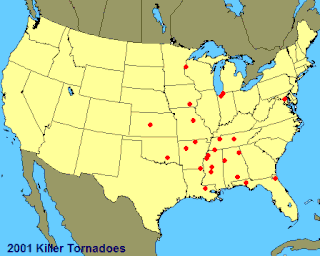
This page documents notable tornadoes and tornado outbreaks worldwide in 2001. Strong and destructive tornadoes form most frequently in the United States, Bangladesh, and Eastern India, but they can occur almost anywhere under the right conditions. Tornadoes also develop occasionally in southern Canada during the Northern Hemisphere's summer and somewhat regularly at other times of the year across Europe, Asia, and Australia. Tornadic events are often accompanied with other forms of severe weather, including strong thunderstorms, strong winds, and hail.

Severe weather is any dangerous meteorological phenomenon with the potential to cause damage, serious social disruption, or loss of human life. Types of severe weather phenomena vary, depending on the latitude, altitude, topography, and atmospheric conditions. High winds, hail, excessive precipitation, and wildfires are forms and effects of severe weather, as are thunderstorms, downbursts, tornadoes, waterspouts, tropical cyclones, and extratropical cyclones. Regional and seasonal severe weather phenomena include blizzards (snowstorms), ice storms, and duststorms.
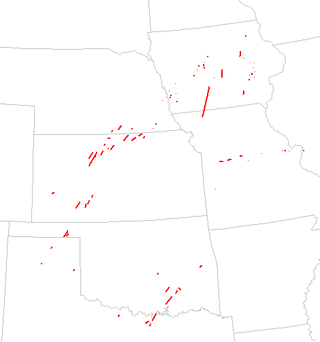
The tornado outbreak of April 10–11, 2001, was a large tornado outbreak which affected the central Great Plains on April 10–11, 2001. During the two-day outbreak, it produced a total of 79 tornadoes across eight states including Kansas, Missouri, Oklahoma, Texas, Nebraska, Iowa, Illinois and Michigan. Four people were killed, 18 injured, and more than $23 million in damage was reported. The fatalities were reported in Oklahoma, Iowa and Missouri including two from a single tornado in Wapello County, Iowa.

Atmospheric convection is the result of a parcel-environment instability in the atmosphere. Different lapse rates within dry and moist air masses lead to instability. Mixing of air during the day expands the height of the planetary boundary layer, leading to increased winds, cumulus cloud development, and decreased surface dew points. Convection involving moist air masses leads to thunderstorm development, which is often responsible for severe weather throughout the world. Special threats from thunderstorms include hail, downbursts, and tornadoes.
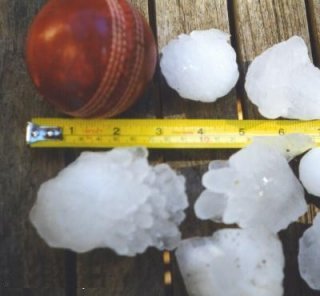
The 1999 Sydney hailstorm was the costliest natural disaster in Australian insurance history, causing extensive damage along the east coast of New South Wales. The storm developed south of Sydney on the afternoon of Wednesday, 14 April 1999, and struck the city's eastern suburbs, including the central business district, later that evening.
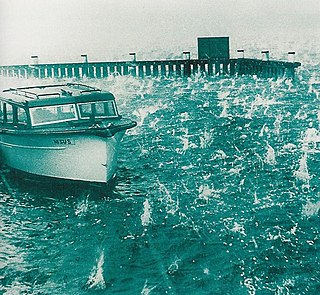
The 1947 Sydney hailstorm was a natural disaster which struck Sydney, Australia, on 1 January 1947. The storm cell developed on the morning of New Year's Day, a public holiday in Australia, over the Blue Mountains, hitting the city and dissipating east of Bondi in the mid-afternoon. At the time, it was the most severe storm to strike the city since recorded observations began in 1792.

The 1995 Mayfest storm was a damaging hailstorm that struck parts of the Dallas–Fort Worth metroplex on May 5, 1995. It was the first singular thunderstorm with a damage toll exceeding $1 billion and at the time the costliest nontornadic thunderstorm in U.S. history. Hail up to 4.5 in (11.5 cm) in diameter fell across Parker and Tarrant counties, producing hail drifts as deep as 3 ft (0.91 m) and damaging numerous buildings. The storm also struck the Fort Worth Mayfest – a local outdoor festival – pelting the roughly 10,000 people in attendance with softball-sized hail and resulting in over 60 hospitalizations. Though there were no hail-related fatalities, the combination of the slow-moving supercell that produced the hail and a larger complex of storms led to deadly flash flooding that killed 17 people in the Dallas area. Overall, 20 people were killed by the storms.
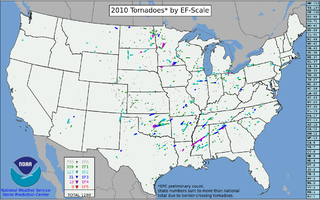
This page documents the tornadoes and tornado outbreaks of 2010. The majority of tornadoes form in the U.S., but they can occur almost anywhere under the right conditions. A lesser number occur outside the U.S., most notably in parts of neighboring southern Canada during the Northern Hemisphere's summer season, but are also known in South America, Europe, Asia, and Australia.

This page documents the tornadoes and tornado outbreaks of 2013. Strong and destructive tornadoes form most frequently in the United States, Bangladesh, Brazil and Eastern India, but they can occur almost anywhere under the right conditions. Tornadoes also appear regularly in neighboring southern Canada during the Northern Hemisphere's summer season, and somewhat regularly in Europe, Asia, and Australia.
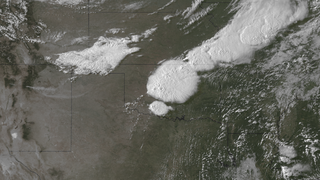
A prolonged and widespread tornado outbreak sequence affected a large portion of the United States in late-May 2013 and early-June 2013. The outbreak was the result of a slow-moving but powerful storm system that produced several strong tornadoes across the Great Plains states, especially in Kansas and Oklahoma. Other strong tornadoes caused severe damage in Nebraska, Missouri, Illinois, and Michigan. The outbreak extended as far east as Upstate New York. 27 fatalities were reported in total, with nine resulting from tornadoes.
Hailstorm Alley is a colloquial term referring to an area of south and central Alberta, Canada where hail storms are frequently produced. These storms frequently produce hail that is damaging to property. This area stretches from High River in southern Alberta, northward through Calgary, through Red Deer to Lacombe and then westward to Rocky Mountain House. It is known to be one of the worst areas in the world for damaging hail produced by thunderstorms. These are regarded as loose boundaries. While this area is common for damaging hailstorms, the reality is damaging hailstorms occur over much of central and southern Alberta every summer. The City of Calgary is regarded as the hailstorm capital of Canada.

The July 1968 United Kingdom thunderstorms were the most severe dust fall thunderstorms in the British Isles for over 200 years. A layer of mineral dust blowing north from the Sahara met cold, wet air over the British Isles, resulting in thick, dense clouds and severe thunderstorms across most of England and Wales. These clouds completely blotted out the light in some areas and the rain and hail resulted in property damage and flooding, and at least four people were killed. During the storm, Leeming Bar in North Yorkshire saw 35.7 millimetres (1.41 in) of rain in under 10 minutes – a UK record until 2003.

This is a list of notable tornadoes and tornado outbreaks worldwide in 2023. Strong, destructive tornadoes form most frequently in the United States, Argentina, Brazil, Bangladesh and East India, but can occur almost anywhere. Tornadoes develop occasionally in southern Canada during the Northern Hemisphere's summer, and at other times of the year across Europe, Asia, Argentina, Australia and New Zealand. They are often accompanied by other forms of severe weather, including thunderstorms, strong winds, and large hail. Worldwide, 116 tornado-related deaths were confirmed – 83 in the United States, 12 in China, nine in Indonesia, eight in Myanmar, three in Turkey, and one in Saudi Arabia.
On May 15, 1697, a severe hailstorm tracked south-westwards between the towns of Hitchin (Hertfordshire) and Potton (Bedfordshire) in Southern England. The storm moved slowly, beginning at 9 am and finishing by 2 pm local time. The parent storm's total track length was at least 25 km (16 mi) long. This hailstorm is widely considered to be the worst hailstorm ever documented in the United Kingdom, with the largest hail ever measured in addition. Widespread damage to property was reported where the hailstorm had passed through, with slate roof tiles smashed to pieces and resulting in at least 1 death.
{{cite web}}: CS1 maint: multiple names: authors list (link)